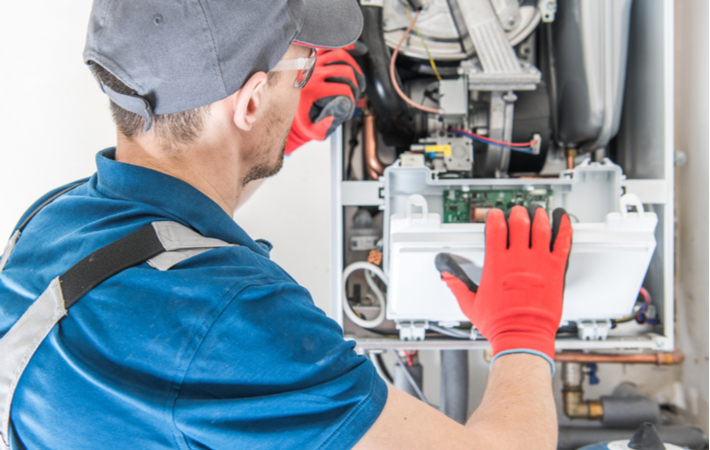Why Your Furnace Breaks Down
Regular Maintenance Prevents Furnace Breakdowns
As winter approaches, a functional furnace is a necessity. When snow is piling up outside, and the temperature is dropping, the last thing you want is for your furnace to fail. Preventative maintenance is key to preventing the majority of furnace failures, so as part of your pre-winter checklist, you should have your furnace professionally inspected, tuned-up, and cleaned.
The Most Common Reasons Furnaces Fail (& How to Prevent Them)
Dirty or Clogged Filters
How Do You Know Your Filter is Clogged?
If your furnace isn’t blowing hot air or makes a racket every time it turns on, a likely culprit is your air filter.
How to Fix the Problem
Depending on your furnace model and your filter type, your filter will either need to be cleaned or replaced.
How to Avoid the Problem in the Future
You should be cleaning or replacing your filter roughly every 3 months. However, if you have someone who smokes in your house, own a pet that sheds, or are allergic to dust, pollen, or pet dander, you should change or clean your filter more frequently. If you aren’t sure if your filter needs to be replaced or cleaned, take a look: if it’s visibly dirty or clogged, it’s time to change it.
Pilot Light or Ignition Failure
How Do You Know Pilot Light or Ignitor Has Failed?
You will know your pilot light has failed when it fails to turn on, even when the furnace is running. Your ignitor may be to blame if your furnace won’t turn on at all, suddenly quits, or is constantly tripping your circuit breaker.
How to Test your Ignitor and Pilot Light
If there is an issue with your pilot light, it’s something that is best left to the professionals. It can be dangerous to tamper with the pilot light without special training, given the potential for things to go wrong. It can be easy to burn yourself, or worse, cause an issue with the gas line.
Never adjust the mechanism or tamper with the gas line on your own. If you begin to feel lightheaded or nauseous, or your pilot light is yellow instead of blue, your furnace may be giving off carbon monoxide. If this is the case, open your doors and window, evacuate immediately, and call a furnace professional.
How to Avoid the Problem in the Future
The only way to avoid having your ignitor or pilot light fail is to have it tested as part of your regular furnace maintenance. This allows a professional to replace any damaged or worn parts as necessary.
The Blower Motor
How Do You Know Your Blower Motor is Broken?
The blower motor is responsible for pushing warm air through your duct system and heating your home. If your furnace is heating up, but no warm air is being dispersed, the culprit is likely your blower motor.
How to Determine if Your Blower Motor is the Problem
Screeching and squealing sounds can be signs of issues with your blower motor. If you suspect a blower motor issue, you should contact your experienced furnace repair specialist to get it repaired or replaced.
How to Avoid the Problem in the Future
The best way to avoid having parts fail is to have them inspected regularly as part of your annual furnace inspection and maintenance routine. Any parts that appear worn or damaged should be replaced before they have a chance to fail.

Fuel Supply Issues
How Do You Know You’re Having Fuel Supply Issues?
If your natural gas-powered furnace doesn't turn on, you may be having problems with your fuel supply line.
How to Fix the Problem
Natural gas is incredibly dangerous, toxic, and volatile. As such, any supply line issues should be left to the professionals.
How to Avoid the Problem in the Future
The best way to avoid having problems with your supply line is to have it inspected as part of your annual furnace inspection and maintenance routine.
Broken Thermostat
How Do You Know Your Thermostat is Broken?
While your thermostat isn’t technically part of your furnace, if it fails or malfunctions, it may impair your furnace's ability to operate effectively.
How to Fix the Problem
First, you need to determine if your thermostat is the culprit. You can test your thermostat by adjusting the temperature up by 5 degrees. If your thermostat is working, you should hear a click, and your furnace should turn on.
If your furnace doesn’t turn on when you adjust your thermostat, make sure your thermostat is on the right setting (particularly if your thermostat has both heating and cooling options).
If you have an electric thermostat, you should also double-check that your thermostat’s batteries aren’t dead. Try replacing the batteries and see if that fixes the problem. If you have a mechanical thermostat, you should remove your thermostat’s cover and give it a thorough cleaning with a small brush or cloth before testing it again.
If your thermostat still isn’t working, you should check its wires to make sure they are connected to their respective mounting screws. If your thermostat still isn’t working, it’s time to call in a professional.
How to Avoid the Problem in the Future
The best thing you can do to ensure your thermostat stays in good shape is to remember to either replace your batteries regularly or clean your mechanical thermostat frequently to avoid dust buildup. While doing so, make sure to inspect your thermostat. If it appears to be damaged or worn, it may need to be replaced.
If you’ve tried all the troubleshooting tips listed above and your furnace is still not working properly, it’s time to call in a professional for help diagnosing and fixing the problem.
Not everyone’s a furnace repair expert, and that’s okay. That’s why the friendly experts at Furnasman are here to help. To help you keep your furnace running smoothly, we offer protection plans that include a comprehensive annual inspection and other benefits.






